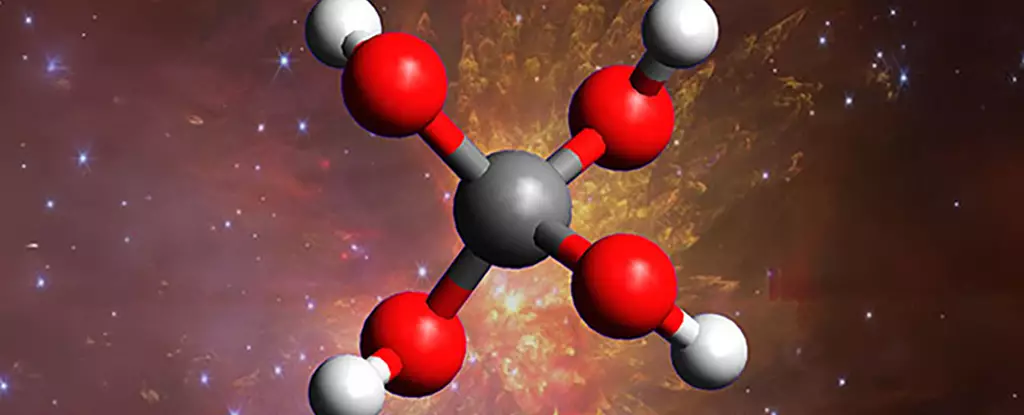The universe continues to surprise us with its boundless complexity, especially when it comes to the chemistry within deep space. Historically, scientists believed that only simple molecules could sustain the harsh conditions of interstellar environments. However, recent groundbreaking research shatters this perception by successfully synthesizing methanetetrol—an extraordinarily unstable, multi-hydroxyl molecule—within laboratory simulations of space. This achievement isn’t just a testament to human ingenuity; it fundamentally alters our understanding of cosmic chemistry and the potential diversity of molecules that exist out beyond our planet.
The creation of methanetetrol, a ‘super alcohol’ with four hydroxyl groups attached to a single carbon atom, illustrates how extreme conditions—ultra-cold temperatures, high-energy radiation, and vacuum—can produce molecules once thought impossible. These conditions mimic the icy interstellar clouds floating between stars, vast regions previously considered chemically inert or overly simplistic. By demonstrating that such a complex molecule can form under space-like conditions, scientists challenge decades-old assumptions and inject new optimism into the quest for understanding the universe’s chemical repertoire.
Implications for Interstellar Chemistry and the Origins of Life
This discovery has profound implications beyond pure chemistry—it may influence theories about the origins of life itself. The cosmos could be teeming with a much richer chemical environment than previously imagined. Molecules like methanetetrol could serve as precursors or building blocks for even more complex compounds, potentially leading to the formation of organic molecules necessary for life as we know it.
Moreover, the findings suggest that the physics of space — especially in dense, cold regions—are more dynamic and chemically active than we ever thought. The fact that such a molecule can form in a simulated environment indicates it might also be present, fleeting yet significant, within actual interstellar clouds. These clouds have long been considered cosmic nurseries for star formation, but now they may also be chemical incubators of extraordinary complexity.
The possibility that other “impossible” molecules could exist in the universe is both thrilling and intimidating. As scientists push the boundaries of what they can simulate and detect, they open new frontiers for discovering unknown chemical species. This expanding catalog not only enriches our understanding of space’s diversity but also presents an intriguing avenue for exploring extraterrestrial life.
The Challenge of Detecting Ephemeral Molecules in Space
While laboratory synthesis provides proof of concept, the prospect of spotting methanetetrol in space remains daunting. Its extreme instability means it quickly breaks apart under exposure to light—specifically through a process called dissociative photoionization—making its detection a significant challenge. Astronomers and chemists now face the formidable task of developing highly sensitive instruments capable of capturing fleeting molecular signatures amidst the cosmic background.
Nevertheless, recent technological advances in telescope sensitivity, spectral analysis, and space-based observation platforms give hope. These innovations may eventually allow us to identify the presence of methanetetrol or its derivatives in the interstellar medium. Detecting such molecules directly would not only confirm laboratory predictions but also revolutionize our understanding of the chemistry occurring in the coldest, most distant reaches of space.
The transient nature of these molecules underscores a broader truth: space chemistry is remarkably different from terrestrial chemistry. On Earth, molecules are stable and can be studied extensively, but in space, stability becomes a rarity. This calls for a paradigm shift in how scientists approach cosmic chemical detection, emphasizing the importance of indirect methods and advanced simulation techniques.
The Broader Significance and Future Prospects
The synthesis of methanetetrol marks a crucial milestone, but it’s merely the tip of the iceberg. As our technological capabilities grow, so too will our understanding of the universe’s hidden chemical universe. Each new molecule discovered adds a layer to the cosmic puzzle—shaping theories about star formation, planetary development, and even the origins of life.
Researchers remain optimistic that more “impossible” molecules await discovery, hidden in the shadows of space. These findings challenge the long-held notion that space chemistry is limited to simple compounds; instead, it hints at an elaborate, vibrant chemical landscape that might be more conducive to life than previously thought.
Moreover, this line of research has the potential to influence multiple scientific disciplines—from astrochemistry and planetary science to the burgeoning field of astrobiology. If complex molecules like methanetetrol can form under space conditions, then the chemical pathways leading to life could be far more widespread and varied than we currently imagine. In essence, we are just beginning to unravel the universe’s chemical secrets, and each discovery fuels our curiosity for what might lie beyond the stars.

